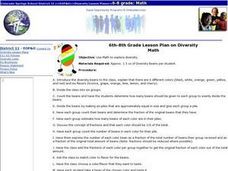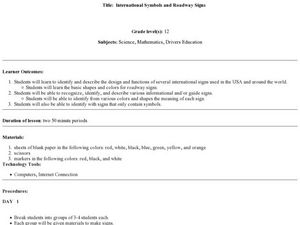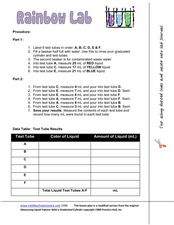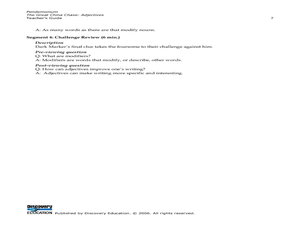Curated OER
Sorting and Analyzing
Students explore sorting and graphing. In this math instructional activity, students create and analyze a class bar graph about their birthday months. They then estimate and sort candies to make and analyze their own bar graph.
Curated OER
Diversity Math- Fractions
Students use jelly beans to gain an understanding of fractions. In this fraction instructional activity, students receive jelly beans and count the number of beans they have in each color. Students then name the fraction for each...
Curated OER
Rain
First graders practice oral and silent reading using beginning comprehension and decoding strategies. In this guided reading instructional activity, 1st graders take a picture walk and make plot predictions prior to reading the...
Curated OER
Outline It!
Fourth graders investigate how outlining can aid in comprehending text. In this reading comprehension lesson, 4th graders outline an article they read in groups of two. Students take turns reading the article, identifying the main idea,...
Curated OER
Thin Layer Chromatography (TLC)
Students study flavinoids and how they exist in the plant kingdom. In this pigment lesson students complete a lab activity to see how flavinoids move in substances then record their observations.
Curated OER
International Symbols and Roadway Signs
Young scholars explore the function of various road signs and international symbols. In this sign recognition instructional activity, students construct road signs with blank paper, markers, and scissors. Young scholars make...
Curated OER
Poetic Math Greeting Cards
Fourth graders work in groups; collect data in a survey; depict in tables, charts, or graphs the results of the survey; and make predictions. They use creative writing skills and computer skills to generate a greeting card of their own.
Curated OER
How Do Organisms Reproduce
Students examine the difference between mitosis and meiosis, and describe the steps involved in meiosis and the significance of each step. They create a diploid nucleus containing two pairs of chromosomes using clay.
Curated OER
Gazing At Cosmic Pinballs
Learners explore the world of stars. They see that the color of a star tells how hot or cold it is, that stars come in different sizes. and that stars are moving through space. They draw lines connecting start to star.
Curated OER
Life size figures - Moveable Murals
Students create life-size human figures and decorate them in a collage style with torn colored pieces of pictures from magazines. They display them around the school, creating life-size murals.
Curated OER
A Box Of Crayons
Students draw self-portraits on die-cut crayon patterns after hearing the poem "A Box of Crayons" in this Art lesson for the elementary classroom. The lesson is ideal for celebrating Martin Luther King Day and includes extra resource...
Curated OER
Skittle Math
In this skittle math worksheet, students sort skittles by color and create a bar graph for each color of skittle. Students also answer comparison, ratio, and relationship questions about the skittles.
Curated OER
Testing for Chemicals in Soils
Young scholars use sight, touch and chemical test kits to evaluate and classify soil types. They determine the organic content, soil pH, conduct visual analysis and nutrient tests of a variety of soil samples from various sources.
Curated OER
I've Felt the Same Way
Students recognize various differences between their lives and the lives of
people living in the 19th century Chicago area. They hear stories from people living in four different historical time periods and match the stories
to their...
Curated OER
Matter for Minors
Students use streaming videos, web sites, and hands on activities students to explore matter. They focus on how temperature affects matter and what the particles look like in the states of matter.
National First Ladies' Library
There's Only How Much? Rationing in World War II
Students discuss the idea of rationing as a restriction on the amount of something or the frequency with which something may be purchased or used in order to contribute to the greater good of the group which was what happened during...
Curated OER
Science Experiment: Take a Rainbow's Temperature
In this science experiment worksheet, students gather materials and perform an investigation using thermometers and prisms. Students are asked if red is hotter than blue. They answer 6 questions.
Curated OER
Worksheet 4-1 Atomic Spectra
In this atomic spectra worksheet, students answer eighteen questions about wavelengths of light, the emission spectrum, energy of photons, the frequency of electromagnetic radiation and electrons in the excited state.
Curated OER
Air Pollution:What's the Solution?-Weather's Role
For this air pollution and weather worksheet, students collect data using an online animation to determine the air quality at given times along with the wind speed and temperature in a particular city. Students make 3 bar graphs using...
Curated OER
Rainbow Lab
In this mixtures activity, students experiment with different amounts of solutes and solvents to make solutions. They observe color changes and look for chemical and physical changes in the test tubes. Students answer 5 questions and...
Curated OER
The Great China Chase: Adjectives
Stories are created, by young scholars, using a variety of adjectives. 3-5th graders will learn about adjectives and use their new knowledge to create ad-lib stories to share with the class demonstrating their mastery of adjectives,...
Curated OER
Probability
Learners explore the concept of probability. In this probability lesson, students perform various probability experiments involving dice, coins, and drawing colored balls from a bag. Learners use knowledge of permutations and...
Curated OER
North American Biomes
In this Science worksheet, students color a biome map of North America. Students color the map by solving the clues listed on a separate sheet of paper.
Curated OER
Light Lab
In this light and the eye worksheet, students perform eight tests to show the blind spot in the human eye, to demonstrate Benham's disk, to show how polarized lenses work, to show how light scatters, to demonstrate fiber...























